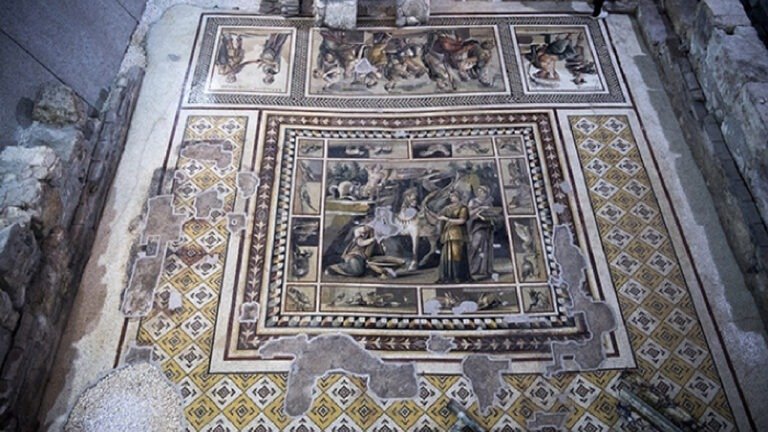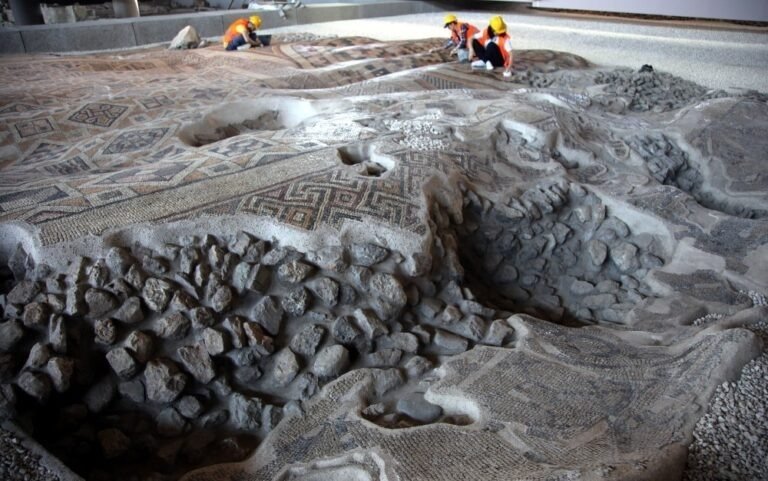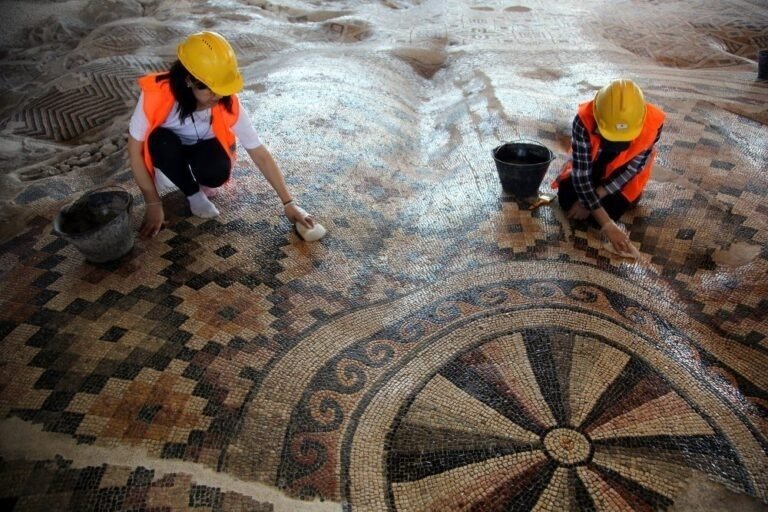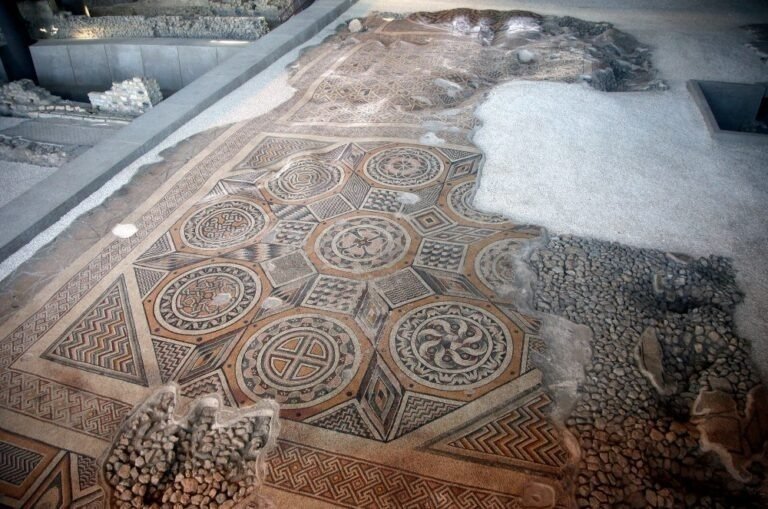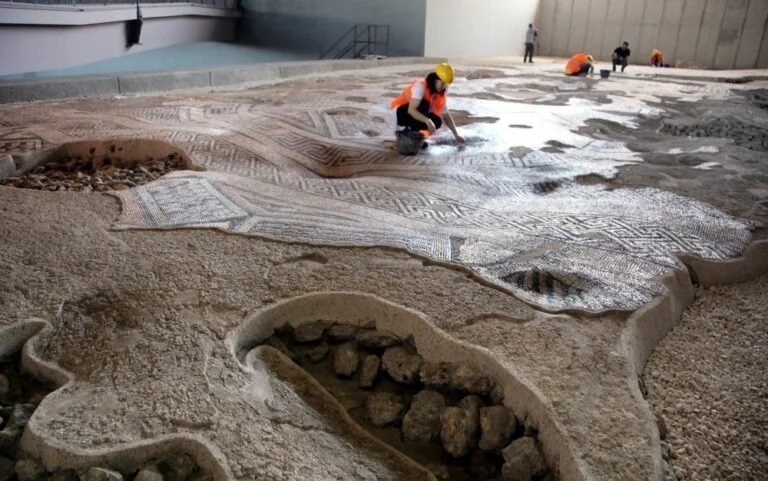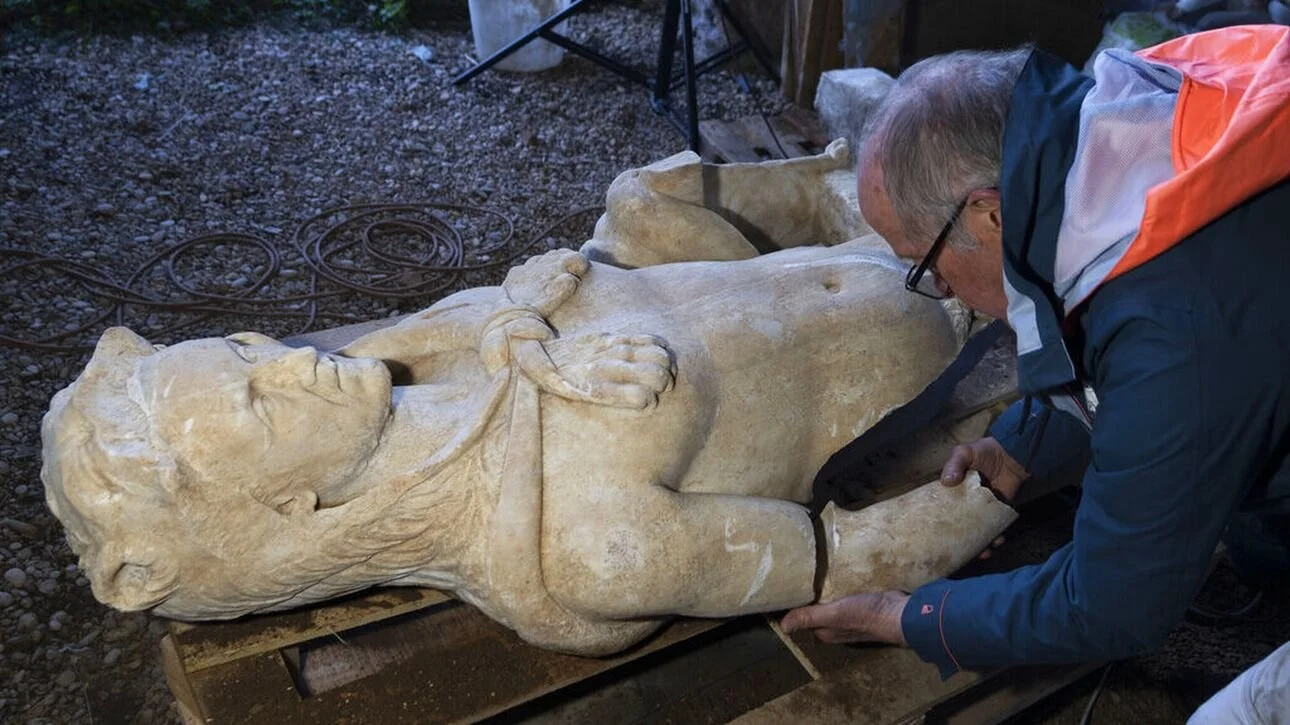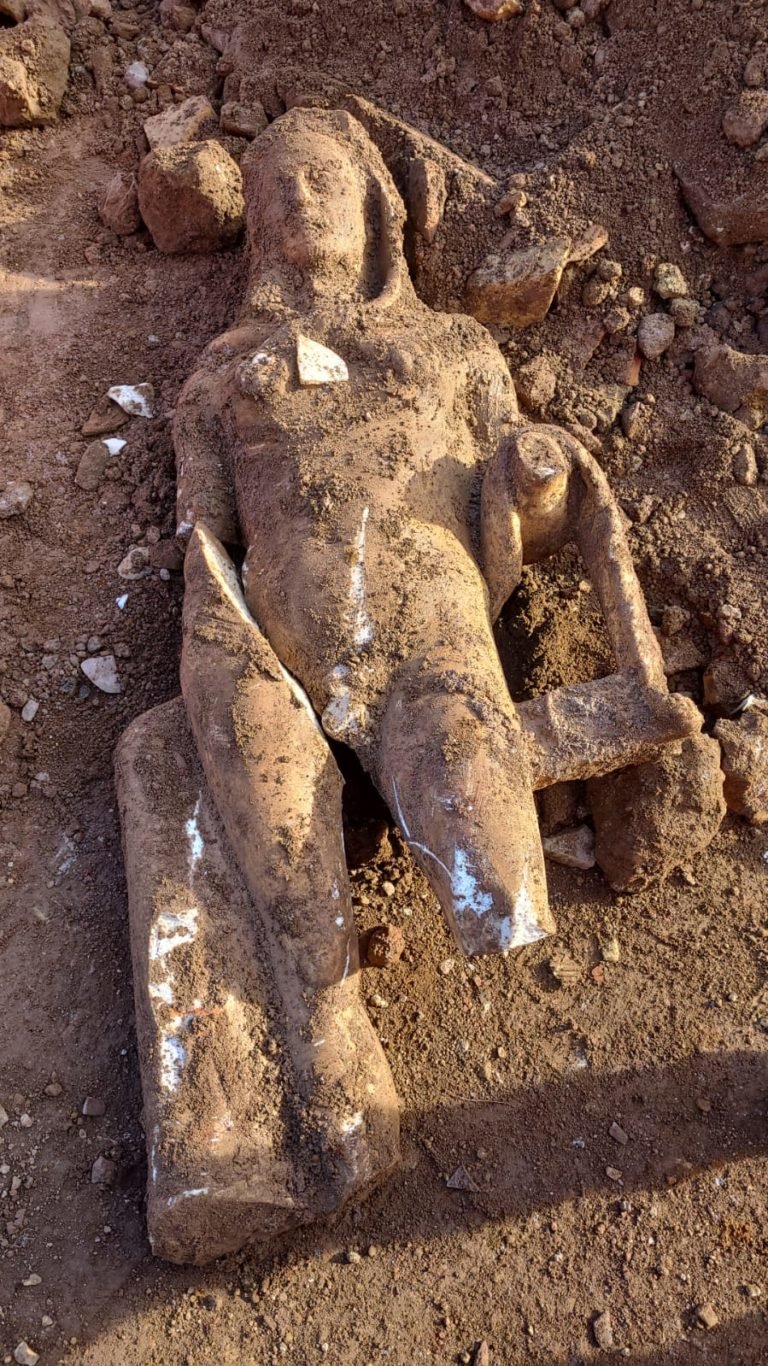In this video we will be analyzing things that Church doesn’t want you to know. Enjoy!
Scientists Terrifying New Discovery Under Antarctica's Ice
In the video below we will be exploring scientists’ terrifying new discovery under Antarctica’s Ice. Watch the video to find out more and enjoy!
Mythical Places & Heroes That Really Existed
In the video below below we will be exploring mythical places and heroes that really existed. Enjoy!
11,000-Year-Old Plastered Skulls of Tell Aswad: The Faces of the Ancients
Over the past few months, I’ve presented videos on various Pre-Pottery Neolithic sites in the Fertile Crescent, from Gobekli Tepe and Karahan Tepe in Turkey, to Tell Qaramel in Syria, Ancient Jericho in the West Bank and Atlit Yam off the coast of Israel.
We’ve seen the incredible art and architecture these people were capable of and we’ve even found their bones, but what did they actually look like? Well, thanks to the 10-11,000-year-old site of Tell Aswad in Syria, we can actually answer that question.
The plastered skulls of Tell Aswad show very realistic faces; there are no unbelievable or supernatural embellishments and they look just like any individual living in the modern era. There looks to be a real intimacy about the faces and the fact they’re around 10,000 years old does stir the emotions.
These are the faces of Pre-Pottery Neolithic people, and that’s according to the people themselves, a truly incredible archaeological find that memorialises our ancestors forever. Watch this video to learn more.
Uncovering Ancient Pyramid Science at Teotihuacan, Where Men Become Gods
Teotihuacan’s Lost Kings , a television special, took an hour long look at the great city, its inhabitants, and the excavation of the Temple of Quetzalcoatl, (also known as the Feathered Serpent Pyramid.) The program revealed evidence of advanced engineering built into a tunnel system, and placed directly underneath the Pyramid. As a team excavated the tunnels, viewers witnessed what must be considered the interior of an ancient generator, where combinations of chemical, mineral, water (and possible electromagnetic fields) were introduced into chambers, resulting in some form of energy. How and where this energy was delivered is still unknown, but based on the design of the complex, we can now speculate as to how the entire facility may have operated.
Note that I have purposely called Teotihuacan a facility, as this is exactly what it was and not a city as many have speculated.
Here’s their amazing discovery.
Mysterious Tunnel
In 2003, Archaeologist Sergio Gomez was walking by the Temple of Quetzalcoatl, when he noticed a large crack in the ground approximately 20 feet (six meters) from the foot of the stairs. Recent rains had opened a surface area, leaving a noticeable divot and exposing tourists to possible injury. Gomez, who had worked at Teotihuacan for over 30 years, inspected the site and determined that something curious lay underneath. Teotihuacan is considered an archaeological park and most archaeologists know that every square foot of land can hold artifacts and important evidence to the past history of the area.
Gomez, a member of the National Institute of Anthropology and History (INAH), received permission to investigate the area, and later that year assembled a team of experts who began carefully removing surface debris. Archaeological excavation is a slow process and as they worked their way down they uncovered a round shaft, similar to a well, perfectly crafted of cement and stone.
Unknowingly, they’d uncovered the main access point to the original design of the complex that dropped down over 40 feet (12 meters). As they descended down into the shaft which opened into a cavern, they cleared over 400 tons of dirt, debris, and portions of discarded buildings, carefully looking for artifacts.
Once in the cavern they noticed the space had been carefully cut out of solid bedrock and opened into a large tunnel. Before the team began removing the debris that blocked entry to the tunnel, Gomez had the space laser-scanned to determine its depth and other clues to its formation. The scans returned images of a precisely cut tunnel that ran more than 330 feet (100 meters) under the pyramid. The scans also revealed odd pockets or small repositories that dropped down from the main shaft and which had the appearance of small rooms.
As the team began to excavate the tunnel, they made the first of many discoveries of artifacts and tools left by those they reasoned were the builders. At the 100-foot mark (30 meters), over 50,000 artifacts were recovered, leading the team to consider a royal tomb was close by.
Strange Pyrite Spheres Discovered
The excavation team also found the first of a number of chemical and mineral deposits buried in the dirt. Hundreds of golden spheres were uncovered in various states of decomposition. They were composed of Pyrite (Fool’s Gold) and a mixture of adobe and crushed rock.
Gomez had also noticed that the walls were covered in pyrite, which gave off a strange glow-in-the-dark effect in the unlit portions of the tunnel. Careful to check the remaining area, Gomez requested another laser scan of the tunnel to determine what lay ahead. To his surprise, the shafts ended in a cross-shaped enclosure, the center positioned directly under the highest point of the pyramid.
As of this writing, the excavation continues in an attempt to discover a royal tomb, but there are a number of critical discoveries which point to the actual purpose of the tunnel system. First, it’s believed the artifacts and offerings were left by the people who rediscovered Teotihuacan over 1,800 years ago and had nothing to do with the original design of the system. A number of important clues offer us a glimpse of the original intent of the pyramid complex and other components which make up this discovery.
Geomagnetic Fields and Pyramids
Recent discoveries in ancient pyramid engineering have suggested that a large number were designed as some form of energy generators by different cultures around the world. In some locations, including Central and South America, construction techniques appear to have been shared.
John Burke, a businessman and scientist, made an important discovery on pyramid electromagnetic energy in 2005. Burke had detected geo-magnetic discharge at a number of North American and European megalithic and mound sites, including Stonehenge, The Serpent Mound in Ohio, and a variety of smaller stone enclosures up and down the eastern coastlines. Using state-of-the-art scanning equipment, including a Magnetometer and Electrostatic Voltmeter, he was able to determine that each location had been chosen because of its naturally occurring telluric energy field that pulsed up and into the structure or surrounding area.
What these sites were used for is anyone’s guess, but we now understand that they may have a positive effect on human physiology and greatly enhanced crop seeds. What’s baffling is how the builders knew how to find the telluric fields without scanning equipment?
Sensing there might be more to electromagnetic energy enhancement, Burke begin scanning pyramid complexes in Central America which were designed with a high level of precision. He would eventually learn about a specific pyramid at Tikal, an ancient Maya city in Guatemala, which was used by the local farmers to enhance their seeds. Known as The Mundo Perdido (Spanish for "Lost World") Pyramid, and considered one of the oldest pyramids in the entire complex (600 BC).
Burke and his research partner Kaj Halberg discovered electro-magnetic signatures that measured impressive charges on top of the pyramid. In a series of scans, the readings showed an average change of 908 volts over a short period of time, which was concentrated in the early morning hours. Burke mentions the readings and states, “These voltages might sound lethal and if it were a household current they could be. However, static electric charge in the air is a different type of electricity and even a thousand volts is not dangerous.” His discovery of pyramid field generation is fascinating, but what he actually uncovered was a means of generating and perhaps distributing electromagnetic energy within a pyramid complex.
What we don’t know about the Lost World Pyramid is if it has other components built into its construction, similar to the Pyramid of the Serpent. We now understand that at a number of Maya pyramids there are key components designed into their construction that act as magnifiers. These components appear to be important in the creation, magnification, and distribution of telluric fields:
Water, either moving naturally including rivers or cenotes (found at El Castillo at Chichen Itza) or by artificial canals or tunnels, similar to the Temple of Inscription found at Palenque.)
Geo-magnetic fields. Naturally formed telluric fields that have high and low period throughout day and night.
Pyramid design. The specific pyramid shape appears to greatly enhance the telluric fields that pulse up and into the center of the chamber.
Pyramid interior fill. At a number of pyramids, rocks that are good electromagnetic conductors fill the interior of the pyramids and are used to enhance the pulsing field. Rocks that have veins with quartz, granite, and other electrical conducting properties appear to be favored.
The chemical and mineral discoveries that Gomez made at Pyramid of the Serpent have many of the same properties found at Maya pyramid locations, with a few twists.
What Made the Pyramid Run?
As Gomez and his team were excavating the tunnel, they discovered water marks high up on the wall. The mark runs the entire length of the tunnel, indicating the space would constantly fill with water. The marks are almost black and appear to have been etched with some chemical concentrate.
The transportation of water was delivered through the stone well shaft from the surface and directed to flow over specific regions of the tunnel.
Recent discoveries of mineral and chemical residue and the design of the well shaft, cavern, and tunnel system, allow one to conclude that the underground system was designed to create some type of discharge which may have taken place in the small chamber that leads to the main cross-shaped configuration at the end of the tunnel.
This discovery of water, minerals, and chemicals has never been a consideration of Gomez or the other archaeologists, whose main goal is excavating the tunnel. In the last few years, the following chemicals and mineral combinations have been uncovered in large quantities throughout the tunnel system.
Pyrite and pools of mercury have been uncovered, and a few years ago, Radon gas was detected passing through a number of areas of the tunnels, requiring workers to wear protective breathing gear. If you combine these elements and a geomagnetic telluric field, the effect may be many times what was detected by Burke at the Lost World pyramid. This is a profound discovery.
An ancient, unknown science designed to create energy directed up and into the pyramid is fascinating to consider and must be analyzed further. Unfortunately, we’re left with more questions than answers. Who were the builders of Teotihuacan?
The Epic Tale of Jason & The Argonauts Explained
Jason and the Argonauts quest for the Golden Fleece is one of the most renowned stories in Greek mythology. The son of Aeson and rightful heir to the kingdom of Iolcos, Jason would have to retrieve the Golden Fleece in order to reclaim his homeland, with the famous witch Medea, the great hero Hercules, and the renowned poet Orpheus all joining him on the adventure.
Long ago, in the region of Boetia, King Athamas ruled with his wife Nephili and had two twin children. Athamas later deserted his family, marrying Eno. Eno became jealous and devised a plan to get rid of the twins. She secretly burned all the city's seeds, causing a famine. Desperate, the people sought assistance from the oracle of Delphi, but Eno had bribed the messengers to lie and tell Athamas that the only way to avoid famine was to sacrifice his first-born son, Phryxus. As Phryxus was about to be sacrificed, his mother, Nephili, appeared with a winged ram and instructed him to escape. Phryxus and his twin sister Heli flew east on the ram, but Heli fell into the water and drowned. The waterway was named the Hellespont in her honor. Phryxus continued his journey and landed in the kingdom of Colchis.
The Insane Secret Life of Eunuchs in Imperial China
Ever wondered what Eunuchs did on a day-to-day basis in Imperial China, and what went on behind the scenes? Today we will look at the shocking secret life's of Eunuchs during Imperial China. Enjoy!
Experts Solved a Vast Napoleonic Mystery by Digging Up A Russian Dance Floor
The remains of General Charles-Etienne Gudin, a one-legged general who served under Napoleon Bonaparte, have been discovered under a dance floor in Smolensk, Russia. Gudin was shot during the 1812 French invasion of Russia, and his heart was sent back to France, where it was buried in a chapel in Père Lachaise cemetery in Paris.
In 2019, Russian and French archaeologists, led by French historian Pierre Malinowski, discovered Gudin's remains in a wooden coffin. The descendants of Gudin and members of the Paris Napoleon 2021 association want him to be laid to rest alongside other military figures in Les Invalides in Paris.
Step back in time as experts unearth a dance floor in Russia, uncovering a tangled web of Napoleonic secrets. Join us as we delve into the mystery and discover the hidden history buried beneath the surface.
Scientists Discovered Evidence That Exposes An Ancient Lie About Woolly Mammoths
Woolly mammoths haven’t roamed the earth for thousands of years, and yet we have no trouble envisioning the massive, hairy beasts. But this well-known species may not actually have lived in the way in which we once thought they did. That’s right: apparently, scientists have uncovered evidence that disproves what was long considered a truth about these ancient animals. And in doing so, the experts may have shed new light on their evolution.
What Happened After The Bronze Age Collapse?
This video covers the period of time from the bronze age collapse through the Near Eastern dark age and to the first Iron Age empire. Enjoy!
Indiana's Mysterious Mounds: Legends of Advanced Civilizations and Giants
Before the first pyramid, or Stonehenge was built, a mysterious people lived in North America. They built large mounds, mostly of earth, sometimes covered in stone, and aligned them to the stars with mathematical precision. They built large cities, with walls up to 25 feet tall, and massively long, And in some of their tombs, were found giant skeletons, ranging from 6 and a half to 9 feet tall. These people dominated the landscape, and yet one day, they vanished, and no one seems to know where they went. This is the fascinating story of Indiana’s mysterious mounds, stone fortifications, and the people that built them.
The history of Afghanistan summarized
In the following video we will go through a summary of Afghanistan’s history. Enjoy!
Could Neandertals Use Symbolism?
If we can see ourselves in the way our ancient cousins dealt with death…what else could we have in common? Watch the video below to find out!
Who Are the Welsh?
Wales occupies a beautiful place within Britain, but it also has a long and storied history. This documentary explores the origins of Wales and the Welsh people (Cymru), from the late Bronze Age to the end of the medieval period, covering some of the most important events that shaped the nation of Wales.
Who Was Solomon And Why Did He Fall? (The Man That Had 1000 Wives And Concubines)
In the following video we will be talking about who Solomon was and why he fell. Enjoy!
This Is Not A Huge Carpet But The World’s Largest Mosaic Unearthed In Turkey
The world’s largest intact mosaic opened to the public on 2019 in Antakya, Turkey, as part of the newly built Antakya Museum Hotel. The 1,300-year-old, 9,000-square-foot mosaic was discovered in 2010. Archaeologists believe this vast mosaic with intricate geometries was the floor of a public building in the ancient city of Antioch. It was damaged during a series of major earthquakes in 526 and 528 A.D., but some of that damage only enhances its spectacular visual qualities because the mosaic remained connected to the floor and mostly intact even as the foundation itself undulated wildly.
Founded in 300 B.C. by one of Alexander the Great’s successor generals Seleucus I Nicator, Antioch was the capital of the Seleucid Empire until it was conquered by Rome in 63 B.C. and became the seat of the governor. Its location made it a hub of trade between the Mediterranean and the East. At its peak, Antioch had a population of half a million and was so important that it was considered a rival first to Alexandria and then to Constantinople as the second most important city in the Empire.
Today Antakya is internationally known for the great number and high quality of mosaics that have been found under its streets. The Hatay Archaeological Museum has a collection of Roman mosaics that is without peer, most of them lifted from excavations and conserved indoors. So it was not unexpected when construction of a new hotel revealed a spectacular late Roman mosaic. The approach taken to its preservation, however, diverged from the well-trodden path of earlier discoveries.
The sheer enormity of the mosaic required a different plan of action. Instead of lifting the mosaic, or part of it, or covering it for its own protection and building over it, archaeologists and architects worked together to create a hybrid: a museum hotel. The Antakya Museum Hotel, located near the Church of St. Peter, a crusader-era church built around a cave believed to be one of the earliest Christian churches in the world, would be built using the archaeology of the site as a lodestar.
EAA-Emre Arolat Architecture placed structural columns along the a former riverbed that crosses through the middle of the site and outside the perimeter of the mosaic. They built a platform on top of the columns to house the hotel’s amenities — ballroom, conference rooms, pool, gym — with passageways and viewing points for guests to view the incredible archaeology beneath them. The rooms are prefabricated units stacked on top of each other, which reduced the amount of on-site construction and the potential damage to the mosaic. The walkways and bridges that connect the rooms create an open space where the archaeology is in sight throughout the building.
Hobbyist with metal detector finds gold medallion from Tudor period
A rare, precious piece of jewelry dating back to the 15th century was found by chance in England by a citizen with little experience with metal detectors.
In 2019, Charlie Clark had just spent six months metal detecting when he discovered a gold medallion in Warwickshire (West Midlands).
The jewelry was engraved with the symbols of the king of the Tudor dynasty, Henry VIII, and his first wife Katherine of Aragon. The first of Henry VIII's six wives had married Henry in 1509.
One side of the jewelry is decorated with a Tudor rose entwined with a bushy pomegranate growing from the same branch. The back is engraved with the letters H and K - for Henry and Katherine. Both sides are inscribed at the bottom with TOVS + IORS, a play on the French word "toujours" meaning "always".
When Clark, still a novice in the field of metal detecting, found the gem, he consulted an expert at Regton, a Birmingham shop, and contacted the British Museum to report his find.
Rachel King, curator of Renaissance works at the British Museum, was shocked when she learned of the discovery, she told CNN. She wondered if it was a genuine artifact, and after the medallion was delivered to the British Museum, it was analyzed to determine if it was indeed from the Tudor period.
One of King's tests dated the jewelry to before 1530, and the curator and her team speculate that the medallion may have been awarded as a prize or worn at a tournament Henry used to organize.
The medallion may change Clark's life if it is sold. He hopes to use the money for his 4-year-old son's education.
In 2021, according to the British Museum, 45,581 archaeological finds were recorded, 96% of which were found by people with metal detectors.
Chania, Greece | Excavation reveals an ancient palace on Kasteli Hill - A hoard of coins was also found
A palace center of ancient Kydonia was discovered during the recent excavations of the Ephorate of Antiquities of Chania, according to the head of the systematic excavations on Kastelli Hill of Chania and honorary General Director of Antiquities and Cultural Heritage, Maria Vlazaki.
In her letter detailing the results of the excavation work, Ms. Vlazaki states:
"The old city of Chania has the great privilege of living, breathing and moving on the ruins of many cultures with strong traces and can be called one of the oldest cities in Europe, whose life began as early as the 4th millennium BC. The city has lived since the 4th millennium BC. The very modern settlement, which is the great obstacle to the unveiling of its past, is at the same time the charm of this city, which is marked everywhere, in its subsoil, its soil and its air, by the ancient aura.
This year's excavations by the Ephorate of Antiquities of Chania, under the direction of the undersigned Dr. Maria Andreadaki-Vlazaki, which took place during the months of October and November on Kastelli Hill in the old city of Chania, confirmed our recently expressed views that with the systematic exploration of the hill and especially in the area of Katre Street, the palatial center and part of the palace complex of Chania and Kydonia from the Minoan and Cretan-Mycenaean periods are gradually being uncovered.
Our hypothesis, already made in the 1980s when the famous "Seal of the Despot" (Master Impression) came to light, that it depicts the palatial center of Chania, located on the hill of Kastelli and being seen from the sea, has now been confirmed.
The research of 2022 revealed two more wooden column bases, which in some way represent the double colonnade of the great hypostyle room - hall of the 14th and 13th centuries BC, which is gradually coming to light as the excavations progress. Also this year we have uncovered more layers of the calcareous gravel floor, due to the effect of the fault that runs through the excavation and that was formed during the earthquake in the 13th century.
The dimensions of the hypostyle room have already reached 18m (N-S) and 10.30m (E-W), without its boundaries being identified so far, except on the north side, where frescoed openings to important rooms were discovered growing up the hill. Moreover, in contact with the north wall, at a point between the two colonnades where the wall painting is interrupted, there seems to have been a wooden piece of furniture (a seat?) on a stone slab on the floor.
Serious evidence leads to the hypothesis that there may have been a third colonnade to the east, which further emphasizes the importance of the site. The gradual exposure of the site is a strong argument that the southern part of the Mycenaean palace of Kydonia is located at this point of the hill. This is supported by the fact that this very site was chosen to receive the atonement offerings of the numerous animal and human sacrifices after the earthquake.
For the earlier neo-palatial period (16th-15th centuries BC), the 2022 survey provided important evidence: The floor in front of the paved corridor uncovered in 2018 was also made of calcareous gravel, but it had a lower thickness and a different texture and technique than that of the 14th century.
As for the younger years, e.g., late 8th and early 7th century (post geometric period I and II ), the site was also open and paved on a large area, partly with sherds of pitho and large vessels with strong fire marks, probably related to a collective activity, perhaps craft.
An excellent clay head of a female deity was also found in these years, a rare find in Kydonia, as well as a corroded and indistinct bronze head, possibly corresponding to the first one.
In the early Archaic period (second half of the 7th/early 6th century B.C.), a significant complex was built in the area, associated with public gatherings and events, as indicated by the large quantity of black isolated cups, as well as the considerable number of anklets, clay flywheels, and weaving stones that come to light each year.
Deep cracks in the clay soils of Late Geometric and Early Archaic times indicate great seismic activity.
The traces of settlement from the classical period are mainly limited to deposits and minimal building elements, if we exclude the construction of the wall of the acropolis of classical Kydonia in the 4th century. For example, in a deposit with a lot of pottery from the Archaic period and some from the Classical period, a treasure of 33 silver coins, mainly from the 4th century, came to light, which is a great find, extremely rare and especially interesting, as it is a collection of coins from many Cretan cities with thriving coin productions. The coins are in a stage of cleaning and care, but most of the images are very sharp. So far, coins from at least 13 cities are known: Kydonia ("Pseudo-Aeginetan"), Aptera, Polyrinia, Falasarna, Eleftherna, Raukos, Tylissos, Knossos, Gortyna, Phaistos, Lyttos, Praisos and Itanos. Perhaps it is a case of private hoarding, that is, the accumulation of wealth from island-wide activities and the hiding of a substantial amount due to hardship.
A very brief investigation in the Lionaki - Vlamaki plot at the intersection of Canevaro and Skordilon roads yielded more pottery that helps to complement the luxurious clay vessels from the early days of the foundation of the Mycenaean palace (before the mid-14th century BC) that had come to light in large quantities in 2021.
The movable finds include a clay tablet with a Linear A ideogram engraved on its apartment surface, depicting a warrior with a shield, and five seal impressions on its edge depicting two Buchanans. Similar panels exist in the Linear A' archive in Katre Street and are certainly related to a specific person and specific products traded in the Minoan palace of the 15th century. e.g.
Also this year, professors Emm. Manoutsoglou (geologist) and Vlasis Koumousis (civil engineer) offered their valuable help in the excavations. Constant is the collaboration of archaeobotanist Dr. Anagia Sarpakis who, with the assistance of archeologists Eleanna Stathakis, Marilena Pantelakis and tour guide Stavros Stavroulakis, examined the archaeobotanical material of the excavation.
Analyzes for aDNA testing of the skeletal material of the young woman from the "Katre 1" excavation, as well as individuals from Kydonia tombs of the same period, were completed at this stage and showed that the inhabitants of Kydonia in the second half of the 14th and 13th centuries had a mixture of local and "immigrant" genetic variation from the mainland Greece. The girl who was sacrificed also belongs to this population.
Analyzes of the ancient human genomes were conducted in the laboratories of the Max Planck Institute for the Science of Human History in Jena, Germany, by Irini Skourtaniotis and Philipp Stockhammer, along with osteological material from other areas of Crete and the Peloponnese. These analyzes provide fascinating information about social organization in the Aegean Bronze Age, as recently announced.
At Kydonia, procedures are also being prepared for authorizing the analysis of a substantial number of charcoal samples from the destruction layer of the Mycenaean palace complex in order to participate in an international research program aimed at tree species identification, tree dating, and radiodating.
The 2022 excavation, funded by the Institute of Aegean Prehistory and supported at the same time by the Ephorate of Antiquities of Chania and volunteers, was attended by Ms. Eftychia Protopapadakis, archeologist of the Ephorate and main collaborator, archeology student Elena Karalekas and archeologists Iro Tsirintoulakis and Eleanna Stathakis.
The master craftsmen were Dionysis Alyfantis, Nektarios Babounakis and Yiannis Bitsakis, whose exceptional skills and years of experience played a crucial role in solving questions and problems. The restorer Alexia Grammatikaki takes care of the conservation of the ceramics and the coins, and the architects Irini Vlazakis and Anna Tsitonakis work on the electronic recording of the excavation and the processing of the plans.
Rome: A statue of a Roman emperor in the shape of Hercules was found
A life-size statue of a Roman emperor in the form of Hercules, the hero of Greek mythology, was discovered during sewer work near the Appian Way ( Appia Antica ), the first major public road in ancient Rome.
The discovery was made when a bulldozer was digging through old pipes that needed to be replaced. The archaeologist supervising the work immediately intervened.
"This face came to light and was immediately recognised as a figure dressed as Hercules," Francesca Romana Paolillo, an archaeologist at Appia Antica Park, told Reuters.
The marble sculpture, which depicts a Hercules-like figure wearing a lion skin and carrying the hero's signature club, was discovered Jan. 25 in Scott Park, part of the Appia Antica green space.
It shows forehead wrinkles that are characteristic of depictions of emperors from the 3rd century, a time of deep crisis for the Roman Empire.
The sculpture bears a "clear resemblance" to Emperor Decius, who ruled Rome from 249 to 251 AD, Paolillo said, adding that discoveries of depictions of Roman leaders with the features of Hercules are "quite rare".
The statue, which consists of several broken pieces and was damaged during its accidental discovery, is currently being cleaned and restored.
Reuters saw the statue when it was stored in an ancient Roman water tank, which has now been converted into a warehouse. It is expected that the statue will be displayed in a public space after its restoration.
Decius was the first Roman emperor to fall in battle against the Goths in what is now Bulgaria, and he was the originator of the first organized persecution of Christians.
When it comes to Rome's ancient history, accidental discoveries of archaeological treasures while digging up streets or parks are not uncommon.
In January, archaeologists said they had given up searching for the remains of the opening of the Via Appia because groundwater made it impossible to dig deep enough.
These are the 15 ancient objects from Switzerland that will be returned to Greece
15 ancient objects from Switzerland, ranging from prehistoric to Roman times, will be returned to Greece. The ancient objects will be returned following a Geneva court ruling in a criminal case against a well-known antiquities dealer, while they were seized by Swiss authorities.
They are figurines, clay and copper vessels, a golden tiara with laurel leaves, the torso of a naked male youth, a bronze statuette of a naked athlete, a pair of bronze anklets and a silver coin (stater).
A statement from the Ministry of Culture said that after being informed of the case by the Consulate General of Greece, the ministry has instructed a lawyer to take all necessary measures to gain access to all the confiscated items. It was found that among them were 15 antiquities of Greek interest. According to the relevant documentation, these items were definitively assigned to the Greek State as products of illicit trade by a court order issued in July 2022.
The Minister of Culture and Sports, Lina Mendoni, stated, "The Ministry of Culture and Sports attaches great importance to the repatriation of all cultural objects that are inseparable from our cultural heritage, especially in recent years. The repatriation of cultural property to its place of origin is not only a universal issue, but also a moral obligation between peoples in the framework of respect and protection of the common global cultural heritage. The need to return cultural property that has been taken unlawfully or through legally questionable procedures stems from the fundamental principles of international conventions, regardless of time limits or restrictions.
In addition to antiquities in the strict sense, there are also antiquities that have been removed, in a way that destroys the monument or the archaeological environment to which they belong. We work systematically on the basis of a holistic management plan, with main axes: the expansion of the protection of cultural properties, the suppression of illegal trade and the return of Greek antiquities to their place.
The Directorate in charge of Documentation and Protection of Cultural Property, in collaboration with all the relevant departments, is working tirelessly and with dedication to achieve both the return of smuggled monuments and the raising of awareness among all citizens about the problem of antiquities hoarding. These efforts have produced very important results, and we are convinced that many more successes will follow. I would like to thank the Greek Consul General in Geneva, Mr. Alexandros Gennimatas, for his decisive contribution to the clarification of the case and the repatriation of the antiquities, the lawyer of the Greek State, Mr. Romanos Skandamis, and for the key role he played in the outcome of this case, the Swiss Archaeological School, as well as the Directorate for Documentation and Protection of Cultural Property for all their actions".









